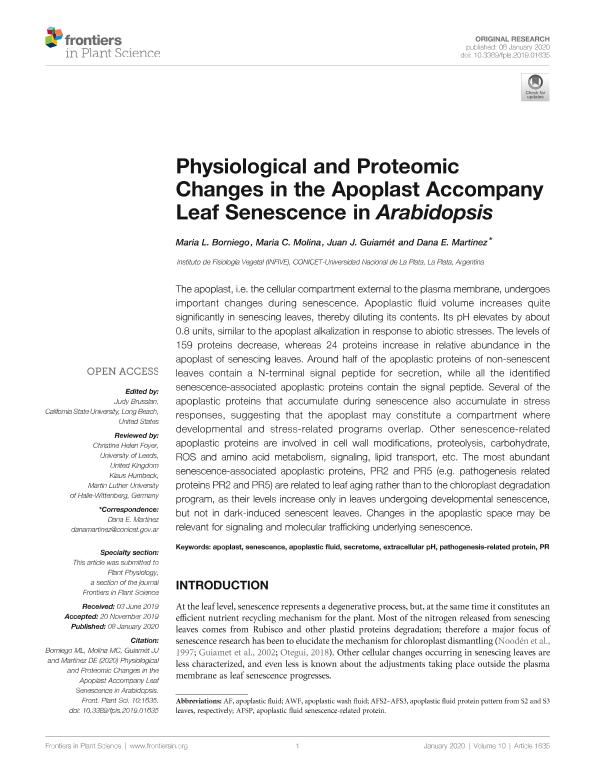Artículo
Physiological and Proteomic Changes in the Apoplast Accompany Leaf Senescence in Arabidopsis
Borniego, María Lucía ; Steelheart Molina, Maria Charlotte
; Steelheart Molina, Maria Charlotte ; Guiamet, Juan José
; Guiamet, Juan José ; Martinez, Dana Ethel
; Martinez, Dana Ethel
 ; Steelheart Molina, Maria Charlotte
; Steelheart Molina, Maria Charlotte ; Guiamet, Juan José
; Guiamet, Juan José ; Martinez, Dana Ethel
; Martinez, Dana Ethel
Fecha de publicación:
01/2020
Editorial:
Frontiers Media
Revista:
Frontiers in Plant Science
e-ISSN:
1664-462X
Idioma:
Inglés
Tipo de recurso:
Artículo publicado
Clasificación temática:
Resumen
The apoplast, i.e. the cellular compartment external to the plasma membrane, undergoes important changes during senescence. Apoplastic fluid volume increases quite significantly in senescing leaves, thereby diluting its contents. Its pH elevates by about 0.8 units, similar to the apoplast alkalization in response to abiotic stresses. The levels of 159 proteins decrease, whereas 24 proteins increase in relative abundance in the apoplast of senescing leaves. Around half of the apoplastic proteins of non-senescent leaves contain a N-terminal signal peptide for secretion, while all the identified senescence-associated apoplastic proteins contain the signal peptide. Several of the apoplastic proteins that accumulate during senescence also accumulate in stress responses, suggesting that the apoplast may constitute a compartment where developmental and stress-related programs overlap. Other senescence-related apoplastic proteins are involved in cell wall modifications, proteolysis, carbohydrate, ROS and amino acid metabolism, signaling, lipid transport, etc. The most abundant senescence-associated apoplastic proteins, PR2 and PR5 (e.g. pathogenesis related proteins PR2 and PR5) are related to leaf aging rather than to the chloroplast degradation program, as their levels increase only in leaves undergoing developmental senescence, but not in dark-induced senescent leaves. Changes in the apoplastic space may be relevant for signaling and molecular trafficking underlying senescence.
Archivos asociados
Licencia
Identificadores
Colecciones
Articulos(INFIVE)
Articulos de INST.DE FISIOLOGIA VEGETAL
Articulos de INST.DE FISIOLOGIA VEGETAL
Citación
Borniego, María Lucía; Steelheart Molina, Maria Charlotte; Guiamet, Juan José; Martinez, Dana Ethel; Physiological and Proteomic Changes in the Apoplast Accompany Leaf Senescence in Arabidopsis; Frontiers Media; Frontiers in Plant Science; 10; 1-2020; 1-20
Compartir
Altmétricas



